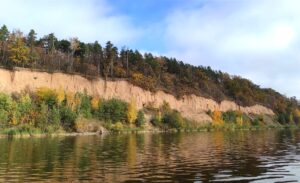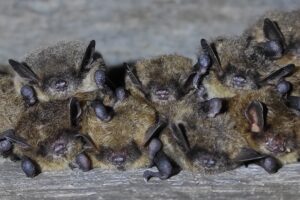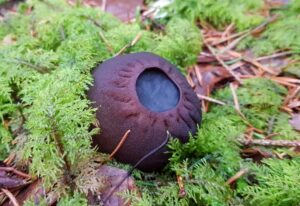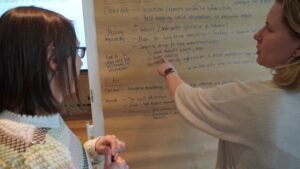Introducing Our New Member: Directorate for Aukstaitija Protected Areas
Sirvėtos RP, Marius Semašk
We are thrilled to welcome the Directorate for Aukstaitija Protected Areas as a new member of our network. This esteemed institution plays a pivotal role in the conservation and management of Protected Areas in the Aukstaitija region, aligning perfectly with EUROPARC’s mission to safeguard nature and cultural heritage.
About the Directorate for Aukstaitija Protected Areas
The Directorate for Aukstaitija Protected Areas is dedicated to implementing state policies and strategies in the realm of Protected Areas. Their core mission revolves around ensuring landscape stability, conserving biodiversity, and preserving cultural heritage. They achieve this through a multifaceted approach that includes protection, rational use, and environmental education.

Daiva Narkūnienė, Kauno mariu atodanga
Main Goals and Activities
The Directorate’s primary objectives include:
– Landscape Stability and Biodiversity Conservation: Ensuring that landscapes remain stable and biodiverse through careful management and protection.
– Cultural Heritage Preservation: Protecting and rationally using areas of cultural significance, ensuring they remain accessible and appreciated by future generations.
– Cognitive Tourism and Environmental Education: Promoting access to natural and cultural protected values by creating conditions for cognitive tourism. This includes educating the public on the importance of environmental conservation and heritage preservation.
Managed Protected Areas
The Directorate for Aukstaitija Protected Areas oversees the management of eight regional parks, each a testament to their commitment to conservation:
1. Anyksčiai Regional Park – 15,459 hectares
2. Asveja Regional Park – 12,207 hectares
3. Biržai Regional Park – 14,406 hectares
4. Gražutė Regional Park – 31,933 hectares
5. Kauno Marios Regional Park – 9,852 hectares
6. Krekenava Regional Park – 11,590 hectares
7. Sirvėta Regional Park – 8,755 hectares
8. Sartai Regional Park – 12,121 hectares

M.Kirstukas, Brandto pelėausiai

Daiva Narkūnienė, Taukius
Commitment to Environmental Stewardship
The Directorate’s work is a shining example of how strategic policy implementation and active management can lead to the effective conservation of natural and cultural resources. Their efforts ensure that these Protected Areas not only maintain their ecological and cultural integrity but also remain accessible for educational and tourism purposes.
We look forward to the valuable contributions that the Directorate for Aukstaitija Protected Areas will bring to our network. Their dedication and expertise will undoubtedly enhance our collective efforts to promote nature and cultural heritage conservation. Welcome aboard!
IUCN categories that the Directorate for Aukstaitija Protected Areas crosses out:
Category Ia — Strict Nature Reserve✔️
Category Ib — Wilderness Area
Category II — National Park
Category III — Natural Monument or Feature✔️
Category IV — Habitat/Species Management Area✔️
Category V — Protected Landscape/Seascape✔️
Category VI – Protected Area with sustainable use of natural resources✔️
What Impressed the Directorate for Aukstaitija Protected Areas Most About EUROPARC

We asked the Directorate for Aukstaitija Protected Areas what aspects of EUROPARC’s mission and objectives impressed them the most. Here’s what they shared:
- The Directorate is particularly impressed by EUROPARC’s role in advising European policy decisions. They value having a platform that shapes policies with insights from experts in Protected Area management. They also appreciate EUROPARC’s commitment to sharing knowledge and best practices. This exchange fosters innovation in managing protected areas, enabling continuous improvement and adaptation to new challenges.
- The Directorate is excited to join a community that values collaboration, innovation, and impactful advocacy.
Our goal is to bring our best practices and share our knowledge within the EUROPARC Federation network. The Directorate would like to participate in the work of Section and several Commissions, take part in conferences and seminars. Exchanging best practices and ideas on better/innovative preservation/restoration of nature and landscape sites is also something that the Directorate hopes to gain from EUROPARC membership.
Apply now: Communications & Digital Media Intern (M/F/D)
A Communications & Digital Media Internship position is now open at the EUROPARC Federation!
Hey communicators! We are looking for YOU!
Are you ready to get real-life experience at an international NGO? Do you want to work in a dynamic environment with loads of opportunities to provide inputs, get creative and explore new ways of communicating? Do you want to craft your communication skills in Europe’s leading Protected Area network? Then keep on reading…
The EUROPARC Federation is looking for an intern to join EUROPARC’s Communications and Capacity Building Unit. Every day, the team is hard at work to communicate about EUROPARC’s projects, events and initiatives, to achieve our vision of Sustainable Nature; Valued by People.
About us
The EUROPARC Federation is a membership based organisation. Our +400 members consist of Protected Areas, national governmental organisations, NGOs, supporting organisations and individual members.
Our goal? Support our members to be the best they can be to ensure positive outcomes for nature and people. Communicating with and for our members is at the very core of our work. That is why delivering excellent communications is a must! Through a range of communication outputs, we want to ensure we keep our members and the wider Protected Area community up to date with all things related to Protected Area management.
About you
Are you a creative thinker, self-starter and passionate writer? Do you know your way around design tools like Adobe and Canva? Do you speak English and preferably at least one other European language? Do you think you can make our Communications Team stronger with your inputs and ideas? Then this internship might just be the opportunity for you!
You will work directly with our Communications Manager in delivering high quality communications for our members and the wider EUROPARC network. In particular, you will be…
- Supporting the Communications Manager with gathering content for our annual journal ‘Protected-Areas In-Sight’. This includes identifying and contacting authors, proofreading, and finding suitable images;
- Taking an active role in creating and designing content for our social media channels, and taking the lead in identifying trends and topics of interest to our core audiences;
- Learning all about WordPress so you can publish articles, review pages and keep the EUROPARC website up to date;
- Providing support to the wider EUROPARC team in the organisation of events (on and offline). This will range from updating our website, creating promotional material, to thinking about interesting programme elements.
- Support the Membership Liaison Officer and Communications Manager with the 2024 membership benefits campaign that is currently in development. This includes ‘admin focussed’ tasks like database hygiene, but also more creative thinking like the design of special communication outputs surrounding EUROPARC’s core work and programmes.
- Given the opportunity to identify YOUR interests and what you’d like the internship to focus on.
Most of all, doing an internship at EUROPARC gives you the chance to be an essential team member, with colleagues coming from all over Europe. Be sure to bring fresh ideas and an open mind!
More details and info on how to apply can be taken from the job description here.
The internship will take place in our Headquarters in Regensburg, Germany. We are looking for someone that can support us 40 hours a week for 6 months, at your earliest possible starting date.
To be eligible, the internship needs to be a required part of your studies. Furthermore, we highly welcome students with ERASMUS+ funding, as this is an unpaid position.
EUROPARC Welcomes Newcomers in April 2024
In April 2024, EUROPARC welcomed representatives from Serbia, Italy, and Belgium, each bringing a unique perspective and dedication to preserving Europe’s natural beauty. Let us delve into the backgrounds and aspirations of these new members, and hear directly from three of them about their journey and hopes within EUROPARC.
Serbia: Nurturing Nature’s Heritage
Serbia presents its champions for biodiversity conservation and sustainable practices. Our new member, Ecological Movement ‘Frame of Life’, has been instrumental in fostering community inclusion in decision-making processes regarding ecological matters. With a keen focus on biodiversity preservation and sustainable agriculture, the efforts of this organisation culminated in the establishment of a Community Seed Bank in 2019, safeguarding traditional crop landraces and invaluable knowledge.
Our second Serbian newcomer, University of Belgrade – Faculty of Biology, adds its venerable legacy of 170 years to the EUROPARC community. Renowned for its pivotal role in biological research across the Balkans, particularly in national-level protection efforts, their expertise promises to enrich the EUROPARC network with a wealth of knowledge and experience.
Italy: Preserving Nature’s Tapestry
Italy sends forth representatives deeply embedded in the conservation fabric of the country. Natural Regional Park of Coastal Dunes from Torre Canne to Torre S. Leonardo, focuses on sustainable tourism and heritage preservation, which, in turn, resonates strongly with EUROPARC’s ethos. By promoting slow mobility and nurturing diverse habitats alongside historical landmarks, they exemplify a holistic approach to conservation.
Similarly, the Regional Natural Park of the Sile River reinforces Italy’s commitment to environmental stewardship. With a mission to protect and enhance the environment while supporting traditional economic activities, they stand as guardians of Italy’s natural heritage, ready to collaborate within the EUROPARC community.
Belgium: Uniting Nature and Society
Belgium contributes its visionaries from the Entre-Sambre-et-Meuse National Park, a testament to the country’s dedication to ecological restoration and community engagement. By uniting various natural regions and fostering rewilding initiatives, they underscore the importance of preserving ecological richness while enhancing local livelihoods. Through environmentally-friendly activities and robust visitor facilities, they aim to reconnect people with nature, ensuring a sustainable future for generations to come.

In exclusive interviews, Santina Grande from the Regional Natural Park of the Sile River, Jelica Novaković from the University of Belgrade, and Ivana Radović from Ecological Movement ‘Frame of Life’ share their impressions and aspirations within EUROPARC:
- What impressed you most about EUROPARC’s mission and objectives?
Santina Grande: The objectives and missions of EUROPARC are the common objectives of the entities that manage protected natural areas. It’s impressive to see a unified approach across diverse European landscapes, highlighting the importance of addressing different realities on a continental scale.
Jelica Novaković: What impressed us most about your mission and objectives was your commitment to the expansion of protected areas, networking, and support for projects that maintain the landscape.
Ivana Radović: We liked the core values and principles that shape the work of EUROPARC. Protection of nature is not possible without these core values, which encourage us to overcome individual interest for the sake of the interests of society. We also appreciate the devotion to restore the connection of people with nature.
- How do you plan to contribute to our community and our common goals?
Santina Grande: Despite the challenges faced by our park, including limited staffing and resources, I am fully dedicated to supporting EUROPARC in any initiatives that impact our park’s territory.
Jelica Novaković: We want to share knowledge and experience through collaboration with colleagues and act at a local level to protect and promote the conservation of protected areas in our country.
Ivana Radović: We can contribute in the areas of sustainable agriculture and agroecology, participatory approaches to local communities and in the domain of use of citizen science in protected areas.
- Are there any particular benefits or resources you hope to gain from your membership of EUROPARC?
Santina Grande: As a new member of EUROPARC, I look forward to the invaluable benefits of engaging in cross-national and European-level comparisons.
Jelica Novaković: We hope to collaborate with colleagues from around the world, share skills and experiences, and form teams for international projects in the field of nature improvement and protection.
Ivana Radović: We would be delighted to gain knowledge and experience through EUROPARC membership, connecting with fellow members to support one another in activities and projects. Specifically, we hope to forge connections with initiatives in South-East Europe.
With these new members, EUROPARC strengthens its dedication to conservation, promoting collaboration and innovation worldwide. Together, they share a vision of protecting Europe’s natural wonders, driving towards a sustainable and harmonious future.
Out now: Siggen Seminar 2024 Report!
From 4 – 6 of March, Marine Protected Area experts gathered at Gut Siggen in Germany to discuss how we can achieve more Effective Management of Marine Protected Areas.
Catching the wave: How can we achieve more effective management in Marine Protected Areas?
The EU Biodiversity Strategy set an ambitious target for 2030, with at least 30% of the sea area to be legally protected (with 10% of the sea area to be strictly protected) by 2030. Furthermore, it clearly identifies the urgency to ensure that all Protected Areas across Europe are effectively managed, with the realisation of conservation objectives and appropriate monitoring. As such, Marine Protected Areas (MPAs) have an important role to play and are called to make a serious effort to improve their effectiveness.
But what do MPAs need to do to reach this target, and how can progresses be monitored and assessed? What guidance, tools and methods would be helpful to improve the management of our MPAs?

Participants exchange at the 2024 Siggen Seminar
To start working on answers to these questions, exchange experience and learn from each other, 10 experts in Marine Conservation gathered at Gut Siggen in Germany. Valuable inputs were provided by expert Sue Wells, who has worked with IUCN, WWF and many other organisations on the topic of Management Effectiveness. She is currently a member of IUCN WCPA Marine Management Effectiveness Task Force.
Seminar objectives
With this seminar, we aimed to:
- Increase participant’s knowledge on why management effectiveness is at the core of EU conservation strategies;
- Share experience on main challenges that undermine effective management of MPAs;
- Acquire knowledge on some of the most common/recommended indicators to assess Management Effectiveness.
Practical approach
To ground the discussions and exercises, three case studies were used as the basis:
- Thea Hamm presented the Lower Saxon Wadden Sea National Park, Germany.
- Lasse Kurvinen presented the Bothnian Sea National Park, Finland.
- Josefine Gottschalk presented the Pomeranian Bay – Rønne Bank Nature Conservation Area.
These case studies provided real life examples of how Management Effectiveness can be implemented and were at the base of all group exercises. Group exercises focussed on the importance of indicators, monitoring and evaluation and how Management Effectiveness fits into the adaptive management cycle. Check out the report for all insights! Furthermore, all presentations and handouts can be found at the event archive page here.
EUROPARC wants to thank all participants for their active contributions. A special thanks is of course also extended to the Alfred Toepfer Stiftung for welcoming us at Gut Siggen.
